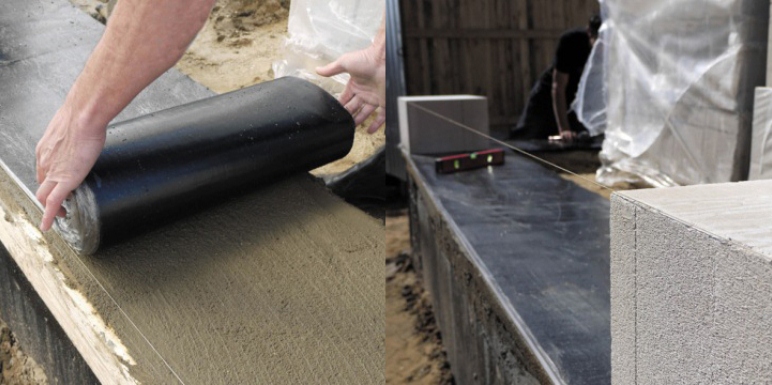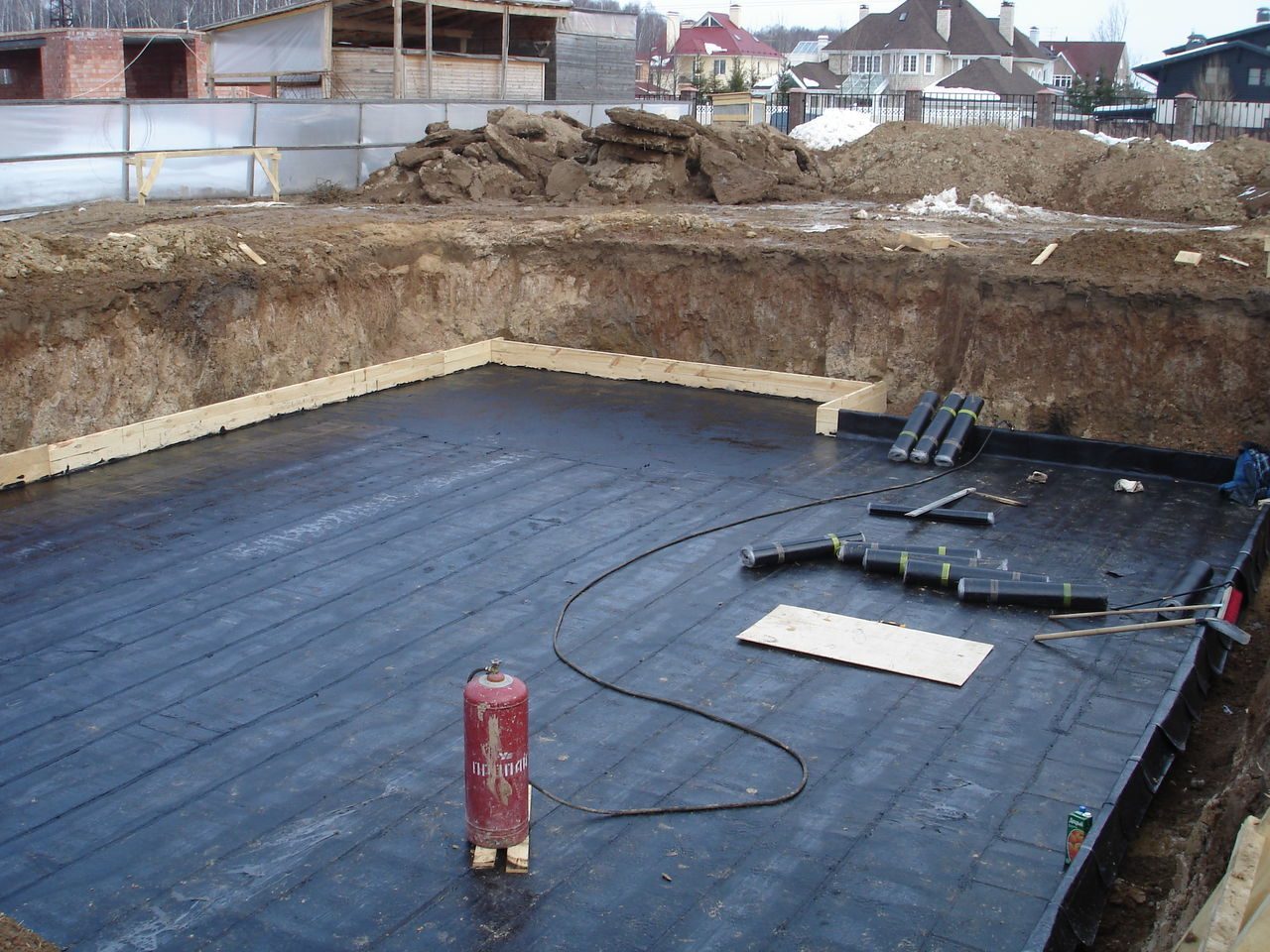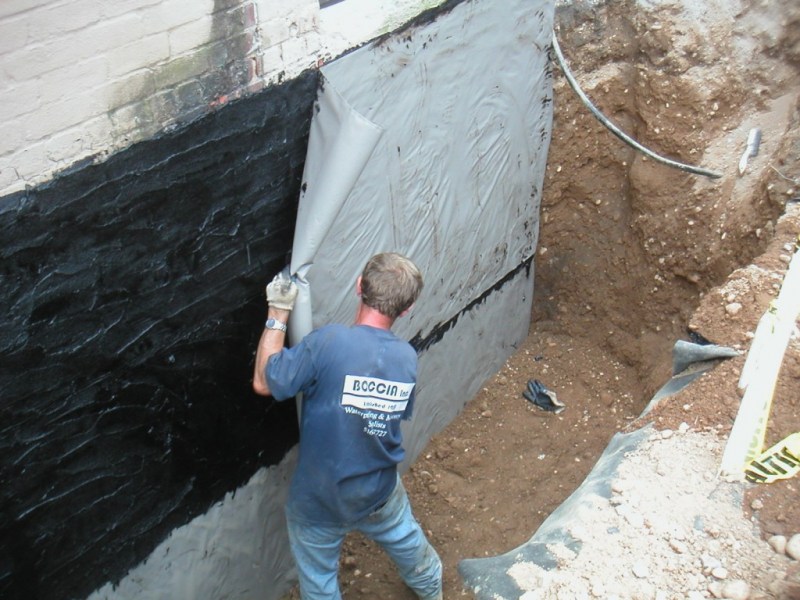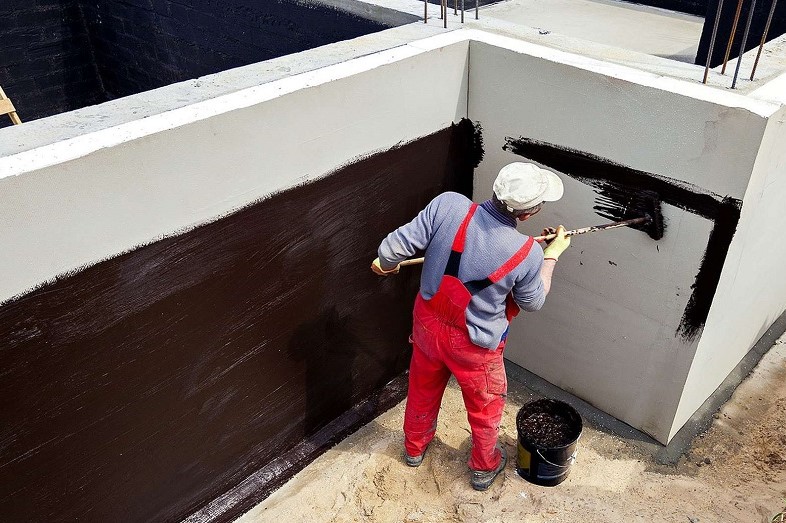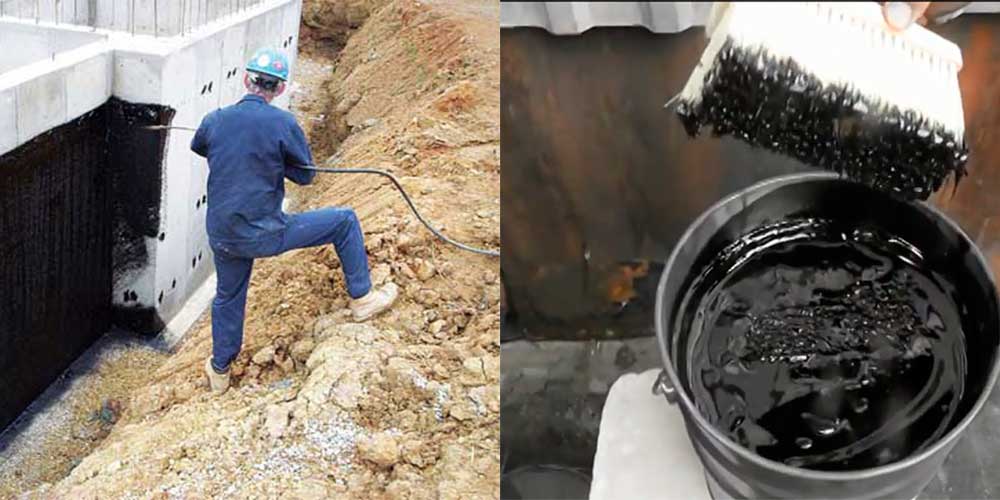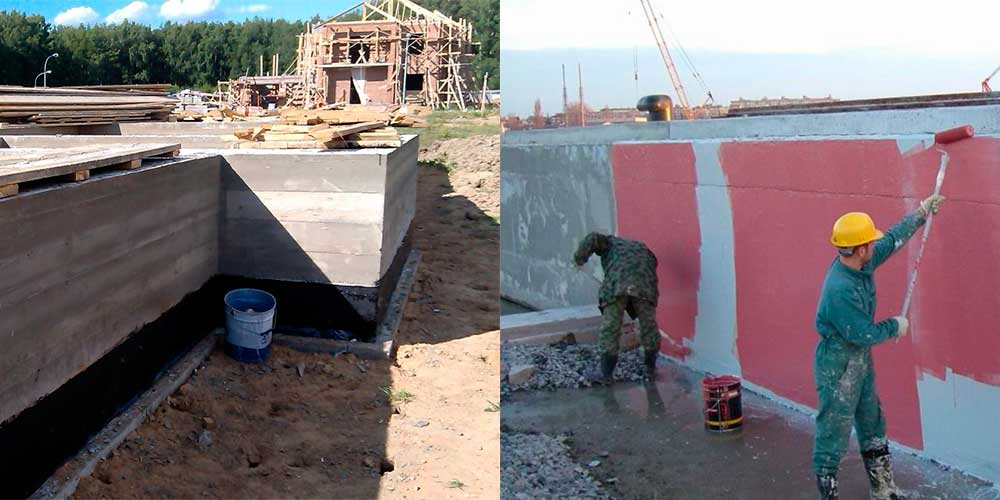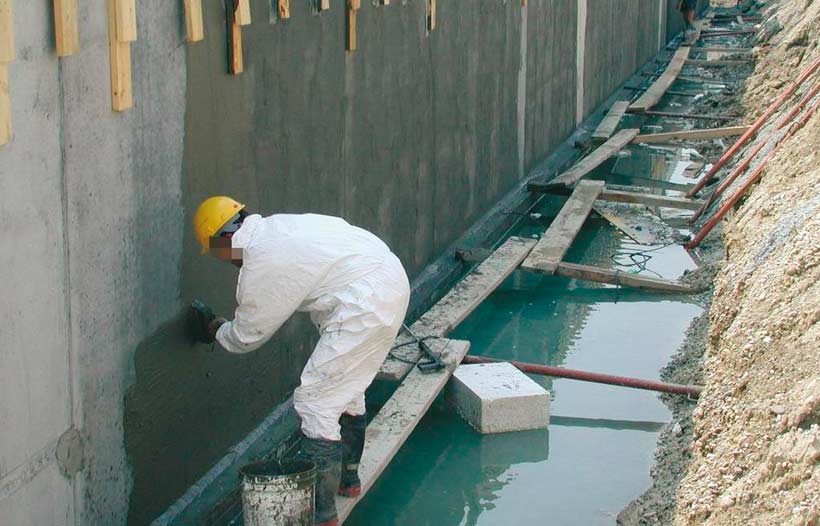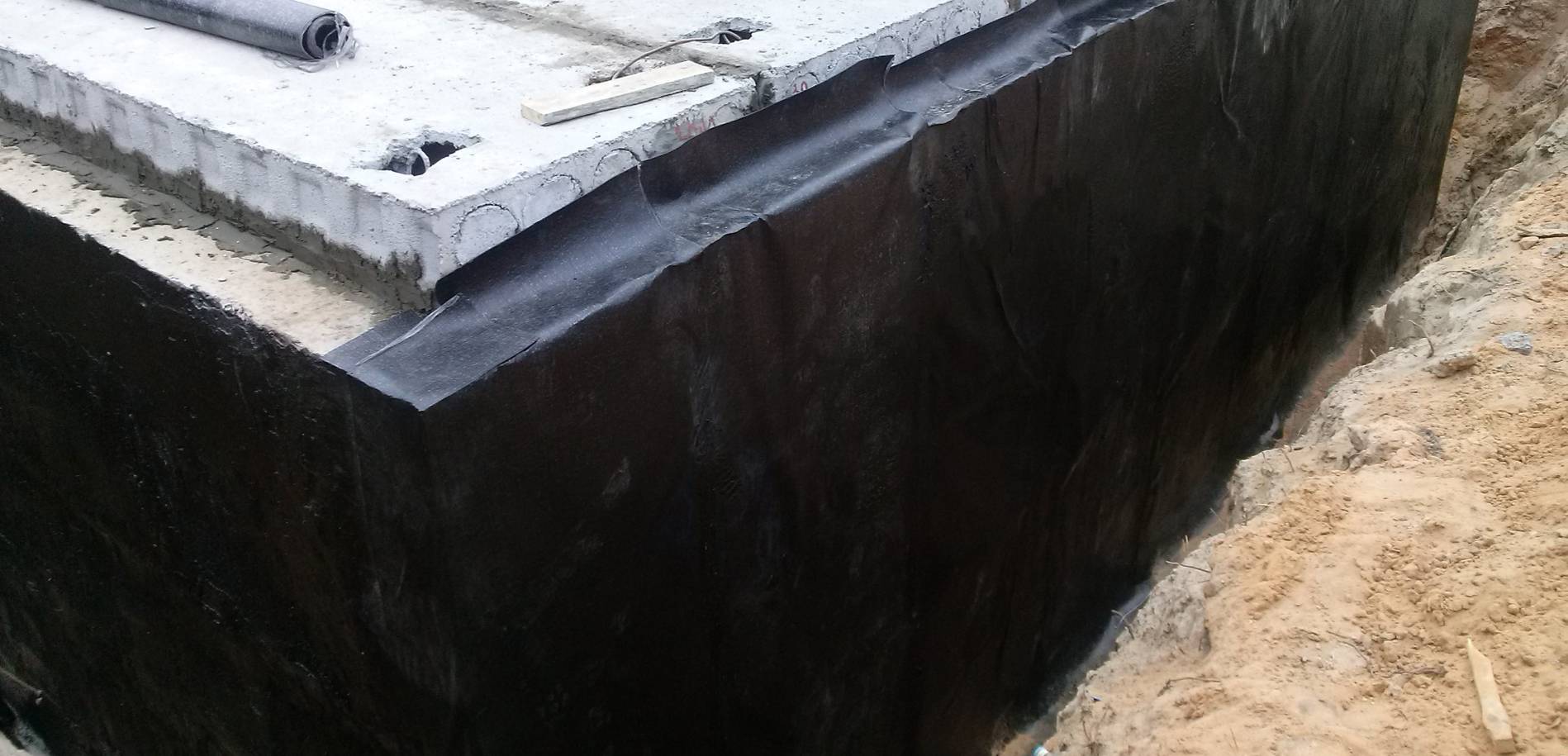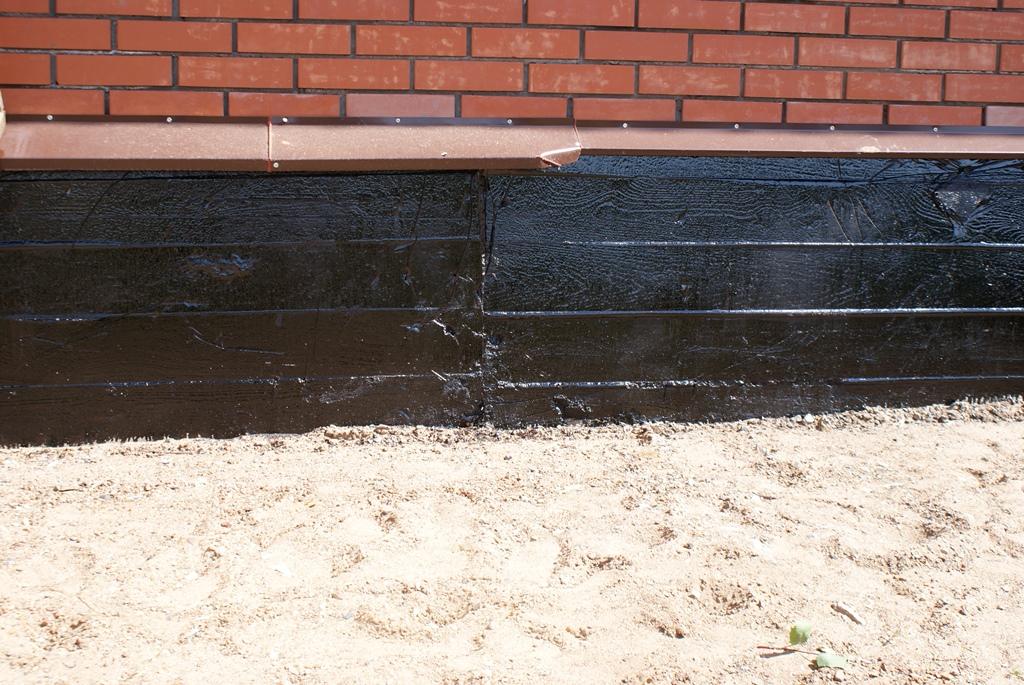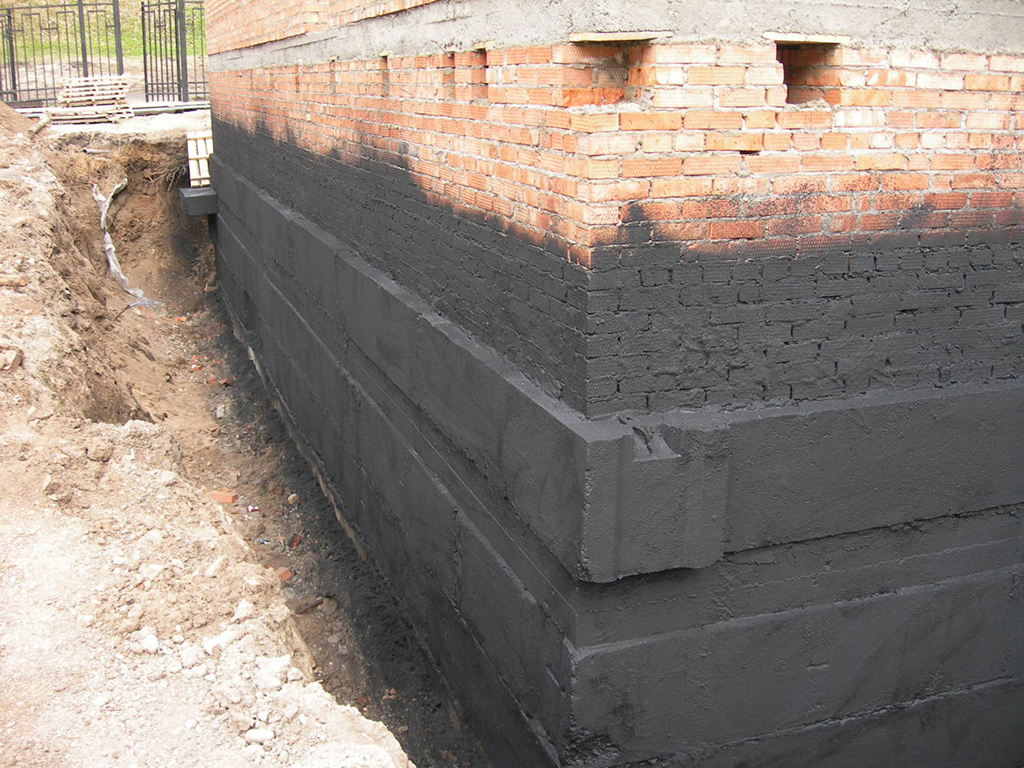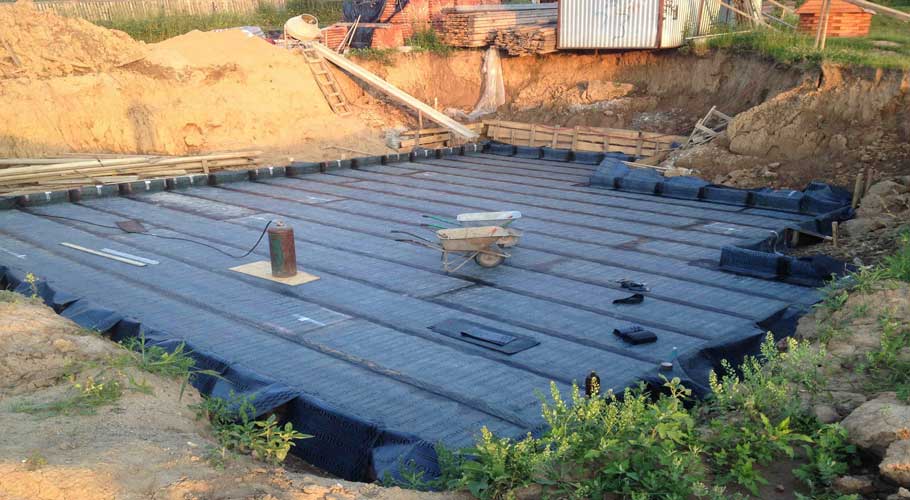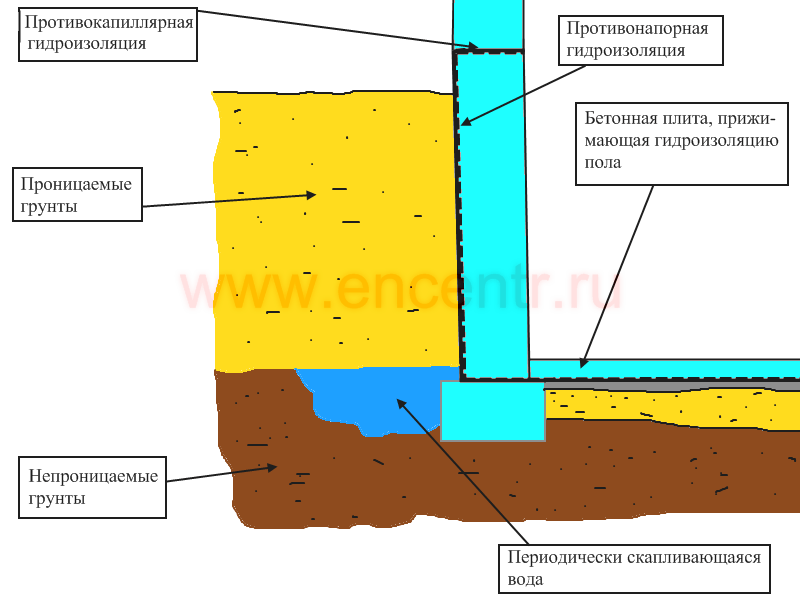There is a solution!
With the help of Dehydrol Lux grade 5, this problem is easily eliminated:
Work technology
The technology for removing excess moisture, waterproofing and protecting the concrete floor and reinforced concrete floor slabs was prepared on the basis that in the treated areas of concrete:
- medium neutral or alkaline;
- concrete is saturated with hygroscopic layers or is used in conditions of high humidity.
- Clean the floor from coatings to screed. Examine the screed for strength and solidity. If the screed is porous, cracked or has a strength of less than 20 MPa, then remove the screed to the concrete floor slab.
- Hydro-insulate abutments, joints and communications inlets with Dehydrol deluxe grade 5 (consumption 1.7 kg / dm3). Fill the detected cavities and voids with Dehydrol deluxe grade 3 (consumption 1.7 kg / dm3).
- Apply Dehydrol Lux grade 5 to the surface of the prepared concrete base with a layer of at least 10 mm. Consumption for a flat layer of material 10 mm thick 17 kg / m2.
- Treat the reinforced concrete floor slab from below with Dehydrol deluxe grade 3. Consumption 1.2 kg / m2.
- It is recommended to apply a polymer coating in the period from 7 to 21 days from the moment when the work on the application of a layer of Dehydrol deluxe grade 5 is completed. Until that time, the layer of Dehydrol deluxe grade 5 should be kept covered with a waterproof polymer film, for example, made of polyethylene or polypropylene.
- If the application of the polymer coating is supposed to be carried out later than the above-mentioned period, then the surface of the layer of Dehydrol Lux grade 5 in 15 days after its application should be treated with Contacid grade 3 with a consumption of 0.2 l / m2. Dilute Contacid grade 3 with water in a ratio of 1: 2 by volume before processing. In this form, the coating can subsequently be used as an independent technical coating (for neutral and alkaline environments), as well as for applying a finishing polymer coating or for laying tiles.
If the medium is acidic, then instead of Dehydrol Lux grade 3, Kontacid grade 1 (consumption 1.8 kg / dm3) is used to monolize cavities and deactivate acids.
If it is planned to work with concreting, it is recommended to use a waterproofing additive to obtain hardened hydro-technical concrete with an accelerated rate of strength gain Dehydrol lux grade 10-2.
How Dehydrol Lux Grade 5 works when "drying" a concrete base
1. The work of Dehydrol deluxe grade 5 as a "desiccant" of a concrete substrate consists of the following parts:
First, part of the moisture is taken from the concrete of the slab to form crystalline hydrates that clog the water-water capillaries in the concrete of the slab.
Secondly, the excess moisture is “squeezed out” from the water channels of the concrete slab into the Dehydrol layer, where it binds in the process of hydration of the Dehydrol cement carrier.
Thirdly, excess moisture in the form of vapor evaporates and goes outside (Dehydrol is vapor permeable).
2. A layer of at least 10 mm of dehydrol dehydrol grade 5 is needed:
First, in order to "pull" as much moisture as possible from the concrete floor, stopping corrosion processes in it.
Secondly, isolate the polymer coating from moisture from the concrete floor.
Note:
If the concrete base is not saturated with hygroscopic or other water-soluble salts, as well as if the high humidity of the concrete base does not threaten its operational properties, then instead of Dehydrol deluxe grade 5, it is allowed to use Dehydrol grade 2P or Dehydrol grade 22 (for large-scale works).
Types and types of waterproofing
There are several methods for waterproofing buildings. A brief description of the methods can be found in the table below.As for penetrating waterproofing, it will be discussed below. But all its advantages cannot be appreciated without knowing the main characteristics of other methods.
 Well waterproofing
Well waterproofing
Table. Waterproofing methods.
| Methodology | a brief description of |
|---|---|
 Coating method Coating method
|
This is a traditional method of waterproofing, which is carried out using bitumen-rubber mastic. This composition, when heated or cold, is applied to the treated surfaces, hardens and creates a durable layer that protects the surface from water. It is required to apply mastics in several layers to improve the quality of waterproofing. Also, a reinforcing mesh can be laid among the layers of material. Bitumen-based mastics are distinguished by good waterproofing properties and are appreciated by builders. The protection against water is strong and durable. |
 Adding additives Adding additives
|
In this case, special additives are added to the concrete. They are similar in action to the very penetrating waterproofing. However, they are demanding on the composition of the concrete. |
 Gluing method, roll method Gluing method, roll method
|
This version of the waterproofing material is a roll that needs to be rolled out over the surface to be protected and fixed on it. Moreover, it protects concrete not only from the effects of water, but also from the action of other external factors. As a rule, roofing material is used as such a waterproofing material. It's cheap and easy to use. Special semi-permeable membranes can also be used. Unfortunately, glued waterproofing is a temporary rather than permanent option. It can quickly deteriorate and stop performing its functions until it is replaced with a new one. |
 Liquid method Liquid method
|
Such formulations are liquid and very easy to apply. This type of waterproofing materials can be applied to the finished surface with a regular brush. In this case, the entire treated surface will be protected from moisture. |
 Waterproofing strip foundation with bitumen and roofing material
Waterproofing strip foundation with bitumen and roofing material
Prices for bituminous mastic
Bituminous mastic
All of these techniques are good, each in its own way, but they also have a number of disadvantages, ranging from a short service life to the complexity of the work. Now a completely new method of protecting concrete from water has appeared - penetrating waterproofing.
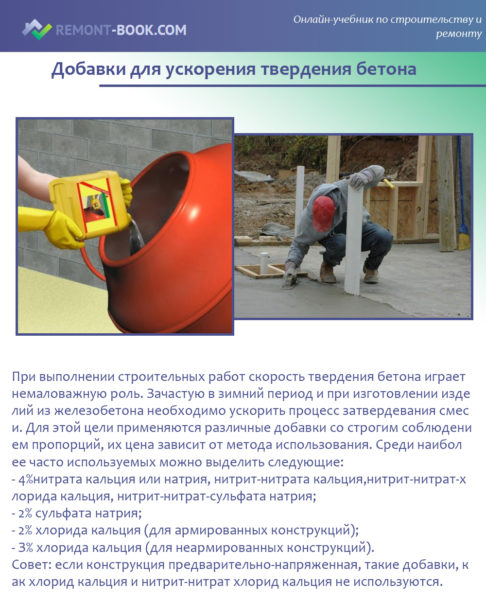 Additives for concrete hardening
Additives for concrete hardening
Waterproofing device (technology)
Preparation of the base
- The base for the coating waterproofing must be solid and solid, with rounded (3-5 cm radii) or chamfered corners and edges. Fillets (fillets) should be made in the places of transitions from a horizontal to a vertical surface to ensure smooth conjugation of intersecting planes.
- Concrete surface with a lot of air bubble pockets with a view to
preventing the formation of bubbles bursting after 10-15 minutes in freshly applied mastic
the layer is rubbed with fine-grained cement mortars from dry building mixtures. - Especially dangerous for mastic waterproofing are "scallops" with sharp and sharp protrusions, which are formed
at the joints of the formwork sheets that must be removed. - The surface of the base is cleaned of dust, dirt, construction debris.
- The waterproofing surface must be dry.
The moisture content of the base is the most important indicator of the readiness of the surface for the application of bituminous mastic. The presence of moisture leads to the formation of blisters or detachment of the mastic from the surface.
The permissible surface moisture for bitumen (bitumen-polymer) mastic should be no more than 4%. Water-based mastics can be applied to damp (up to 8%), but not wet substrates.
The simplest moisture test involves placing a 1x1 m polyethylene film on a prepared concrete surface.If condensation does not appear under it in 4-24 hours, then the application of bituminous waterproofing is possible.
Primer application
- To improve the adhesion (adhesion) of the mastic to the concrete surface, the prepared base is primed with a bituminous primer (ready-made bitumen primer).
The primer can also be prepared from bitumen (grades BN 70/30, BN 90/10, BNK 90/30) and a rapidly evaporating solvent (gasoline, nefras), diluted in the ratio
1: 3–1: 4, by weight or bituminous mastic with heat resistance above 80 ° С, diluted to the required consistency.
The type of primer (primer) must correspond to the applied mastic.
The primer composition should be applied over the entire surface in one layer, in the places of abutments along the grout from a cement-sand mortar - in two layers.
Bituminous primer is applied to the surface with a roller or brush. The base, which has dried out after priming, is ready for the beginning of the coating waterproofing device.
Application of mastic
- Bituminous mastic is applied to prepared surfaces from the moisturizing side (water pressure side).
- The mastic is applied in layers with a roller, brush, spatula, or in bulk. Each layer should be continuous, without breaks, uniform thickness, parallel stripes. The direction of application of bitumen mastic is from bottom to top.
- The next layer of mastic should be applied after the previous one has hardened and dried (there should be no traces of the binder on the attached tampon).
Waterproofing reinforcement
In places of abutments and junctions, where cracks may form, places where cold seams are located, cracks detected in monolithic concrete, etc. of defects, the coating waterproofing must be reinforced.
As a reinforcing material, it is recommended to use fiberglass materials (fiberglass and fiberglass), or geotextiles with a density of 100 to 150 g / m2. Possibly also
strengthening of such "problem" places with roll materials.
The fiberglass material is sunk in the first layer of mastic and rolled with a roller, which ensures tight adhesion of the panel to the base without the formation of voids under it. After the system "bituminous mastic - reinforcing material" has dried, the second layer of mastic is applied. The overlap of a strip of fiberglass or fiberglass on both sides of the axis of the problem area should be at least 100 mm.
Availability
reinforcing material in the waterproofing coating results in tensile load distribution
for the entire strip of insulation, reduces the elongation of the material at the point of crack opening, which provides
preservation of its continuity, reliability and durability of waterproofing.

Backfilling of walls with coated waterproofing should be done only with soft soil; in this case, a protective coating (screeds, walls) is not required.
Foundation waterproofing

The foundation of any building must be carefully protected from the harmful effects of groundwater. Surfaces can be waterproofed in different ways. One of the most modern and accessible methods of protection is the use of coating-type waterproofing materials.
The importance of waterproofing for the base of the building
Concrete as a material is a monolithic structure. But in fact, it has a fairly large number of microcracks and pores, through which moisture can freely penetrate into the block and get onto the reinforcing mesh.
As a result, over time, corrosion inevitably forms, which contributes not only to the weakening of the foundation block, but also to the complete destruction of the rods.
In addition, moisture is capable of interacting with the concrete itself and leads to untimely destruction.
In the event that the block bursts, the entire building as a whole can sag. To prevent this from happening, all elements of the base must be carefully processed.And the coating waterproofing of the foundation in this case will be very useful.
Advantages of coating waterproofing
Any coating waterproofing is a reliable coating, consisting of several layers at the same time. Its thickness can vary within a fairly wide range: from 1 mm to 10 mm. The final thickness of the foundation waterproofing treatment layer is determined depending on the condition of the surface.
Foundation waterproofing has a relatively short operating period - from 5 to 6 years. But since it is not particularly difficult to repeat the processing, this factor does not affect the demand for the material.
Foundation waterproofing is used most often in the following cases:
- for internal protection against water penetration by capillary;
- for external protection against groundwater.
At its core, coating waterproofing is a fairly thin layer that is formed as a result of multi-layer application of a special composition to the surface to be treated.
Internal treatment is most often required in situations where a building or structure is being erected on soils where soil water is located very close to the surface, as well as if the walls are cracked.
Foundation waterproofing involves the use of bitumen or bitumen-containing materials. On average, their consumption can vary from 2 to 3 kg per 1 cm2 of area.
The disadvantages of bituminous coating materials include:
- short service life;
- loss of elasticity at low temperatures;
- the danger of working with materials (associated with the high temperature of the application of the material).
All kinds of synthetic materials based on them have replaced bituminous compositions.
For example, bitumen-organic or bitumen-rubber cold-applied materials based on an organic solvent.
However, it should be noted that even the most modern coating waterproofing of the foundation has a relatively low resistance to various kinds of vibrations, deformations and other mechanical influences.
Features of working with coating waterproofing
Foundation waterproofing coatings can be sold as a paste or liquid mix, or in dry formulation. The first option is already completely ready for use. And complete with dry mixes are polymer emulsions, which are used to prepare the material for work.
The consistency of the mixture has a direct impact on the possibility of creating a waterproofing layer of one thickness or another.
So, liquid mastics based on oxidized bitumen should be applied in several layers (at least two). The first layer is applied with strokes, which should be done in a uniform direction.
In the case of waterproofing pastes made on the basis of polymers with the use of mineral additives, they are also applied in two layers. Moreover, each of the layers should be no thicker than 3 mm. Since the layer thickness is relatively large, this type of insulation is most often reinforced. For this, it is better to choose a plastic mesh.
It is quite easy to apply coating-type waterproofing materials. To do this, use a wide and soft brush.
Preparatory stage
First of all, you should decide what type of waterproofing is required for a particular foundation. This takes into account:
- the height of the groundwater;
- soil characteristics (degree of homogeneity, tendency to swelling, movement, etc.);
- operating conditions of the building.
It is recommended to contact a professional for a geological examination of the site. Only in this case you will receive objective information and will be able to choose the optimal type of waterproofing for the foundation.
In the case when the distance from the bottom plane of the foundation to the highest level of groundwater rise is more than a meter, it is allowed to use coating waterproofing to protect the walls of the structure, and cover the upper plane with roll material (roofing material).
If the groundwater is able to approach the base of the foundation less than a meter, but does not fill the basement, in addition to the coating waterproofing of vertical surfaces, roll materials are used (they are glued or fused), and a "pie" of two layers of roll material is mounted on the horizontal surface and a layer of waterproofing mastic between them. It is also recommended to pre-treat the reinforced concrete structure with penetrating waterproofing.
The same version of waterproofing is used if the groundwater is located at the level of the foundation or the floor in the basement, or the clay soil does not allow moisture to pass through well, and it is in contact with the base of the house for a long time. But in this case, the rolled material is attached not in two, but in three layers, but a drainage system is laid along the perimeter of the foundation base.
The total cost of high-quality waterproofing of the base of the house with your own hands depends on the choice of materials and installation technology, on the surface area that you want to protect from moisture penetration.
Note! Installation of the waterproofing layer on the vertical surfaces of the foundation can be done after the construction of the house is completed, but the horizontal layer must be installed before the walls are erected.
Vertical waterproofing
Vertical waterproofing is a way to deal with high humidity, in which the walls of the base of the building and the basement are strengthened. It is possible both at the stage of construction of an object and during preparation for construction.
Vertical waterproofing is made from the outside of the base of the building and is applied to the level of the sidewalk or blind area. However, there are several types of vertical waterproofing.
Bituminous waterproofing
The use of bituminous waterproofing is considered the easiest and most affordable way. The bottom line is that contractors treat the foundation with bitumen mastic, as a result of which the substance penetrates into all cracks and gaps, filling them. This feature of bitumen mastic helps to protect against moisture, and, therefore, the strength of the base of a wooden house is ensured.

If you bought a bitumen block, you should melt it to a liquid consistency in a container, after which you need to apply the mixture in several layers (from two to four)
It is important to remember that the surface must be processed at one time with melted bitumen mastic, because repeated heating of the substance will lead to the loss of useful properties
Pros:
- ease of use;
- the availability of building material;
- low cost.
Minuses:
- not a very high level of waterproofing;
- relatively short service life of the mastic - up to 15 years.
Roll waterproofing
Rolled waterproofing of a wooden house using roofing felt is the application of a layer of one of its types: techno- or isoelast. This method can exist both independently and as a supplement to the previous type of insulation. The process of installing protection is very similar to laying a roof. You need to take a special burner, heat the roofing material and overlap it on the base, already treated with a bitumen mixture. Roofing material joints are also heated and fixed.
Pros:
- long service life - up to 50 years;
- acceptable price.
Minus - a rather difficult process for independent execution.
Waterproofing with plaster
Waterproofing with plaster means creating a homogeneous mixture for strengthening a wooden house from the plaster itself with the addition of components that are resistant to any level of moisture.The base is impregnated by applying the substance with a spatula to the walls of the foundation. Such a composition not only protects against the ingress of groundwater, but also evens out the very base of the object.
Pros:
- low cost of materials;
- ease of application of waterproofing.
Minuses:
- short service life - up to 15 years;
- the possibility of cracking over time;
- insufficiently high level of protection against moisture.
Liquid rubber
If you decide to use liquid rubber, then the base will be reliably protected, because it is perfectly sprayable and serves your family for a long time. Before applying the substance, the foundation and plinth should be treated with a special primer.
There are two types of liquid rubber - elastomix and elastopaz. The first type is applied in one layer and cures within a few hours. After opening the container with the mixture, the substance will no longer be stored for a long time, it must be fully used before setting. As for the second type, the mixture can be applied in two dense layers, and the remains will be stored in the container for some time.
Protection of the foundation is a very important stage in the construction of a house, since the further operation of the building will depend on how it is done. If everything is done correctly, the house will stand for many years.
Trust me, these are just some tips on how to protect the basement and foundation of your home. Experts will help you determine, already during the initial preparation, which type of moisture insulation is best for the basement of your particular house.
Penetrating materials for waterproofing
Penetrating waterproofing materials differ from others in that they change the structure of the components of the foundation, and do not isolate its surface from moisture. For this purpose, mixtures are used that penetrate deep into the concrete structure. This can significantly reduce the exposure of the foundation to capillary moisture.

Penetrating mixtures can be applied with a brush
The principle of operation of such isolation is simple. The components of mortars and waterproofing mixtures interact with aluminum and calcium ions contained in concrete, forming complex type crystalline hydrates. The pores in the concrete base are gradually filled with needle crystals, but very small gaps remain. Water molecules can penetrate through them in the form of steam. Capillary moisture penetration is impossible due to the presence of surface tension of the droplets.
Liquid formulations
For arranging waterproofing with penetrating compounds, liquid mixtures are often used that are easy to use. They are optimal for new foundations without cracks or defects. In this case, the concrete base can be processed both from the outside and from the inside.

Penetrating waterproofing is timeless
The technology for applying liquid penetrants for waterproofing a foundation is simple. The complex of works includes the following mandatory stages:
- Cleaning the surface from dust and dirt. It is possible to process with a hard brush and then with a strong jet of water.
- Material preparation. The dry mixture must be diluted with water according to the instructions. The result is a composition with the consistency of a very liquid sour cream.
- Material application. Do this with a wide brush. The first layer is kept for about 6 hours, and then the next one is applied.
-
Cracked foundation treatment. To do this, you need to dilute the powder to a thick consistency, and then apply the composition to the surface with a spatula.
- Decorative processing of the foundation. It is possible at least 21 days after waterproofing.
This method is distinguished by simple technology, and the choice of funds is very extensive. For example, there is a demand for the Penetron mixture, which is distinguished by its mechanical strength and high quality.
Hot or cold?
Its main advantages are its availability and economy. However, there are also disadvantages, primarily associated with the fragility of pure bitumen.Due to temperature changes, it becomes more rigid, loses its former elasticity and becomes less resistant to cracking. Therefore, a more practical product is foundation waterproofing mastic. In addition to the bitumen itself, it contains special additives, including:
- mineral wool;
- asbestos dust;
- ash;
- thickeners;
- quartz, lime and brick powders.
There are two main varieties of this coating material, and they differ in their temperature characteristics. So, hot mastic must be heated to at least 150, and at most 300 degrees C. This is a rather complicated procedure, but it allows you to get an extremely strong and elastic film. It will never shrink and is an ideal solution in difficult climatic conditions.

Waterproofing application
It is very easy to prepare "hot" mastic yourself. Aviation kerosene, filler (for example, cement), as well as other "ingredients", including modern latex or polymer additives, should be added to a container with hot bitumen. At the exit, a viscous, viscous mass is obtained, which is characterized by a low solidification rate.
Another option is “cold” mastics. They do not need to be heated, they are UV resistant and come in a variety of shades. To obtain a coating material, you need to mix the mastic with a solvent, after which the mixture will gradually harden and acquire its operational properties.
What are the hydraulic components of protective water-repellent mixtures
In order to increase the durability and strength of the structure and to protect it from unwanted moisture, special active additives are also used. They have a positive effect, among other things, on the frost resistance indicators of the structure as a whole.
They have a good effect on the process of laying structures made of concrete, and also increase its non-delamination and toughness.
With the use of such elements, it can be achieved that the degree of moisture absorption by the foundation is reduced by half. This is quite enough not to use any additional technical devices and chemicals.
Moisture protection of the base of the structure being erected is a prerequisite for the building to last for many years and will be strong, reliable and stable.


